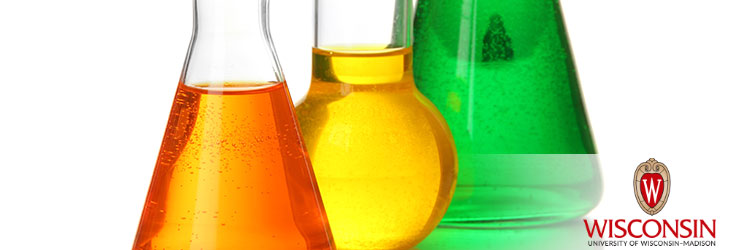Materials & Chemicals

Method to Produce Sorbic Acid and Pentadiene from Renewable Biostock
WARF: P100264US01
Inventors: James Dumesic, Mei Chia
The Wisconsin Alumni Research Foundation (WARF) is seeking commercial partners interested in developing a biorenewable method to produce sorbic acid and pentadiene, two commercially significant compounds.
Overview
Sorbic acid has been used extensively as a preservative in a vast array of food. The benefits of sorbates as food preservatives are two-fold: sorbates inhibit a wide spectrum of bacteria, yeasts and molds, and they have extremely low toxicity. Several protocols for producing sorbic acid and sorbates are known. However, the most common method of producing commercial quantities requires a decomposition step that yields unwanted, colored byproducts. Multiple purification steps are required to yield product that is food grade or better.
1,3-pentadiene, or piperylene, is a volatile, flammable, linear five-carbon hydrocarbon. It is used widely as a monomer in the production of plastics, adhesives and resins. It is produced commercially as a byproduct of ethylene production, and no other means of producing 1,3-pentadiene in commercial quantities is known. A method of making sorbic acid that overcomes the formation of byproducts and yield losses of known methods while also resulting in the creation of 1,3-pentadiene is needed.
1,3-pentadiene, or piperylene, is a volatile, flammable, linear five-carbon hydrocarbon. It is used widely as a monomer in the production of plastics, adhesives and resins. It is produced commercially as a byproduct of ethylene production, and no other means of producing 1,3-pentadiene in commercial quantities is known. A method of making sorbic acid that overcomes the formation of byproducts and yield losses of known methods while also resulting in the creation of 1,3-pentadiene is needed.
The Invention
UW–Madison researchers have developed a method of making 2,4-hexadienoic acid (i.e., sorbic acid) and 1,3-pentadiene (i.e., piperylene) via an acid-catalyzed ring-opening of 6-methyl-5,6-dihydro-2-pyrone (i.e., parasorbic acid). The parasorbic acid can be made from a renewable precursor, 4-hydroxy-6-methyl-2-pyrone (HMP).
The method comprises converting a renewable feedstock, HMP, into parasorbic acid (PSA), and then opening the ring of the PSA by contacting the PSA with a solid acid catalyst. This can be performed with acid-catalyzed ring-opening to yield sorbic acid or with decarboxylation of the opened ring to yield pentadiene. The conversion of HMP to PSA is accomplished by hydrogenating the HMP in the presence of a catalyst comprising one or more noble metals. The conversion takes place in a solvent selected from the group of C1- to C6-alcohols and C1- to C6-carboxylic acids, and the ring-opening reactions take place in a polar, aprotic solvent or a mixed solvent of water and a polar, aprotic solvent.
A more specific, three-step approach begins by hydrogenating 4-hydroxy-6-methyl-2-pyrone (HMP) to yield 4-hydroxy-6-methyltetrahydro-2-pyrone (4-HMTHP). Then, the 4-HMTHP is dehydrated by contacting it with a solid acid catalyst to yield parasorbic acid. Finally, the ring of the PSA is opened by contacting the PSA with a solid acid catalyst to yield sorbic acid or pentadiene.
The method comprises converting a renewable feedstock, HMP, into parasorbic acid (PSA), and then opening the ring of the PSA by contacting the PSA with a solid acid catalyst. This can be performed with acid-catalyzed ring-opening to yield sorbic acid or with decarboxylation of the opened ring to yield pentadiene. The conversion of HMP to PSA is accomplished by hydrogenating the HMP in the presence of a catalyst comprising one or more noble metals. The conversion takes place in a solvent selected from the group of C1- to C6-alcohols and C1- to C6-carboxylic acids, and the ring-opening reactions take place in a polar, aprotic solvent or a mixed solvent of water and a polar, aprotic solvent.
A more specific, three-step approach begins by hydrogenating 4-hydroxy-6-methyl-2-pyrone (HMP) to yield 4-hydroxy-6-methyltetrahydro-2-pyrone (4-HMTHP). Then, the 4-HMTHP is dehydrated by contacting it with a solid acid catalyst to yield parasorbic acid. Finally, the ring of the PSA is opened by contacting the PSA with a solid acid catalyst to yield sorbic acid or pentadiene.
Applications
- Production of biorenewable chemicals including sorbic acid and pentadiene
Key Benefits
- Provides a streamlined method of producing both 2,4-hexadienoic acid and 1,3-pentadiene from renewable feedstock
- Presents an opportunity to convert dihydro-4-dydroxy-6-methyl-2H-pyran-2-one to 3-penten-2-one, a useful and reactive unsaturated ketone, as an intermediate
Tech Fields
For current licensing status, please contact Mark Staudt at [javascript protected email address] or 608-960-9845